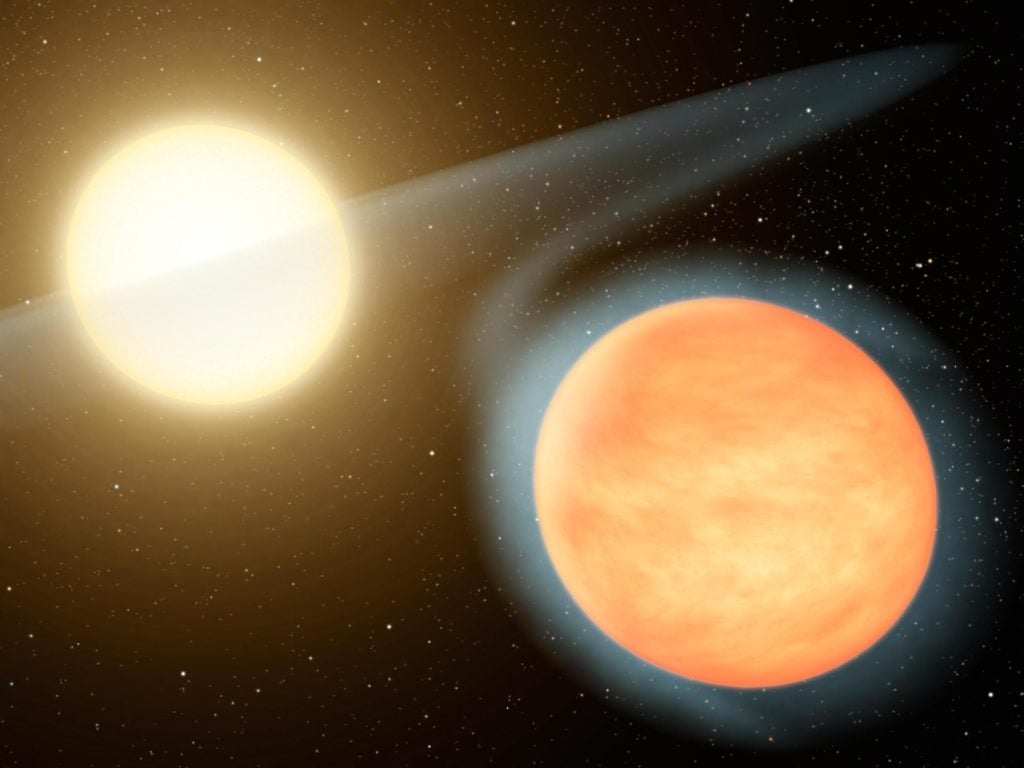A waltz with Doom

Imagine a planet hurtling towards its doom, locked in a deadly embrace with its star. This is WASP-12b, a world on a collision course with destiny, where gravity is the ultimate destroyer.
This doomed world, discovered in 2008 by the aptly named SuperWASP project—because who wouldn't want to search for planets with that name?—is a gas giant orbiting a star about 1,300 light-years away in the constellation Auriga. Imagine Jupiter, but way hotter, much closer to its sun, and a lot more stressed. That's WASP-12b.
How Did We Find It?
Astronomers used the transit method. Basically, they watched the star's light, and when WASP-12b passed in front of it, there was a tiny dip—like a blink from the star. That blink revealed the planet's existence.
Extreme Characteristics
WASP-12b is a big boy, about 1.8 times the size of Jupiter and 1.4 times its mass. But its defining feature is its ridiculously tight orbit. It whips around its star in just over a day! That's like the Earth completing a year in a day. This proximity makes it a "hot Jupiter," with surface temperatures soaring above 2,200 degrees Celsius.
A Planet in Crisis
Now, here's where things get dramatic. WASP-12's gravity is like a cosmic Pac-Man, slowly munching on itself. The planet is being tidally disrupted, which is a fancy way of saying it's being stretched and squeezed out of shape. It’s less of a sphere and more like a cosmic egg.
The stress doesn't stop there. WASP-12b is losing its atmosphere. Imagine a planet constantly shedding layers of itself like an onion. The Hubble Space Telescope has even seen this happening! They've detected carbon, oxygen, and silicon in the cloud of gas and dust surrounding WASP-12b, which is basically the planet's insides spilling out.
The Final Act
The long-term forecast for WASP-12b? Not good. In a few million years, its star will completely engulf it. This is a planetary tragedy playing out in slow motion.
Why It Matters
But this cosmic drama isn't just entertainment. It's science! WASP-12b is a unique space for studying tidal disruption and atmospheric stripping. It helps us understand how planets behave under extreme conditions and what happens when planetary systems get a little too close for comfort.
Diamond in the Sky?
Another fun fact: WASP-12b's atmosphere is super rich in carbon. It is so rich that some scientists think it might have clouds made of graphite or even diamonds!
So, while WASP-12b is on a suicide mission, its sacrifice is helping us unlock the secrets of the universe. The demise of WASP-12b is a poignant reminder of the unforgiving nature of the universe, yet it also reminds us of the boundless capacity for scientific discovery and wonder.
Similar Post You May Like
-

CFCs, HFCs and their long, troubled history
At its peak, the ozone hole covered an area 7 times larger than the size of Europe, around 29.9 million km2, and was rapidly expanding
-

The Origin of Universe: Deciding point where it all began!
Let us unravel and surf through the ideas throughout ages to understand what the universe and its origin itself was to its inhabitants across history.
-

The Artemis Program
Inspired by the Greek goddess of the Moon, twin sister to Apollo, the artimis program was named on 14 May 2019 by Jim Bridenstine.






